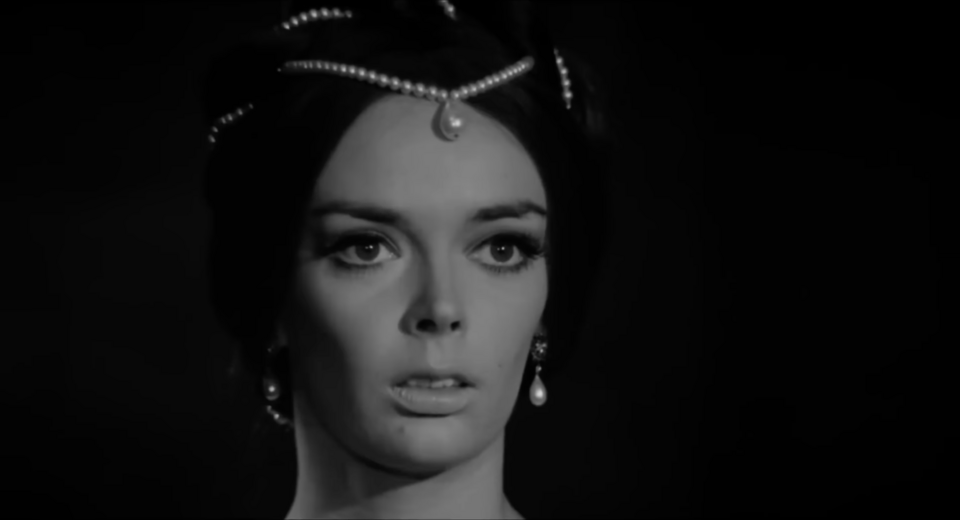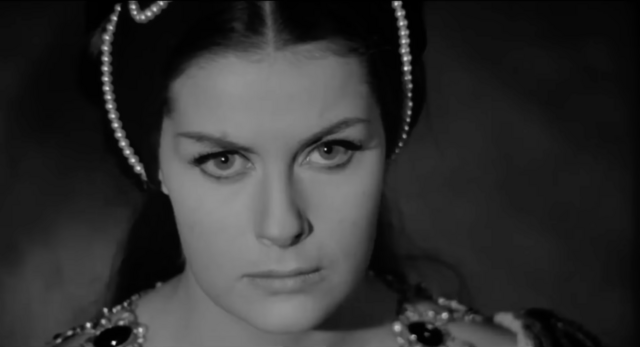
I lunghi capelli della morte
Italy, 1964
Director: Antonio Margheriti
Screenwriters: Antonio Margheriti, Tonino Valerii (Story: Ernesto Gastaldi)
Genre: Gothic horror
Soundtrack composer: Carlo Rustichelli
Production company: Cinegai S.p.A
Main actors:
Barbara Steele (Helen)
Giorgio Ardisson (Kurt, Count Humboldt’s son)
Halina Zalewska (Elisabeth, youngest daughter of the executed woman)
Umberto Raho (Count Humboldt)
Plot
The action takes place in 15th century Europe. Adele Karnstein, a suspected witch, is led to the stake. Her daughter Helen tries to ask Humboldt, the feudal lord of the land, for clemency. Adele is accused of having caused the death of Count Franz, Humboldt’s brother, through her dark arts. But Helen insists on her mother’s innocence. She knows who the real murderer is, it is someone the aristocrat has “under his protection”. Helen is willing to “do anything” to stop the execution.
Humboldt, seeing the desperation of the attractive young woman and that she has no other alternative than to be solicitous and submissive, takes the opportunity to satisfy his lustful desires with her…
But for Adele it is already too late. The fire of the bonfire burns, under the watchful eye of the priest von Klage, the superstitious villagers and little Lisabeth, the youngest daughter of the condemned woman. As the flames engulf her, Adele utters a curse that overwhelms those present. She directly threatens Humboldt, and predicts a plague that will spread through his domain in the coming years. Count Humboldt, who hears the dire omens from the bedchamber where he is wallowing with Helen, turns pale with terror.
Shortly thereafter, Humboldt decides to get rid of Helen; throwing her into a waterfall to drown. Lisabeth is taken into a nun’s orphanage, and one of the nuns reveals to her where her mother’s ashes and her older sister’s body are buried.
Lisabeth grows up to be a good-looking wench. She soon catches the eye of Kurt, Humboldt’s son and heir. The father is already cruel and ruthless, but his son far surpasses him in wickedness. Kurt wants to marry Lisabeth, but she detests him. Humboldt does not think the marriage is a good idea, for the girl “is the daughter of a witch” and the curses that the necromancer pronounced shortly before she burned are already coming true: The county is plagued by drought and pestilence.
Amid ominous laughter, Kurt confesses to his father that it was he who killed Franz – his uncle and Humboldt’s brother – so that the title of Count would pass to his branch of the family. Humboldt is already too old and ill to react to this news. The constant preoccupation with the witch’s prophecies has taken its toll on his health.
The wedding between Kurt and Lisabeth eventually takes place. She still hates him: “You will have my body but not my soul. I will never be completely yours.” Meanwhile, the plague continues to ravage Humboldt’s domain. The priest von Klage believes that the “Apocalypse” is coming. But a miracle happens: It begins to rain. With that the drought ends, and the plague seems to be able to be kept under control from then on. But that same night when the rain breaks, while the thunder and lightning of the storm lashes the castle grounds, old Humboldt dies. At the same time a strange phenomenon occurs in the nearby cemetery: Helen’s skeleton begins to “grow” again and the young woman who had died years before comes back to life… When she is resurrected, she walks towards the fortress and faints at the gates. On Kurt’s orders, she is taken to a room to recover. No one recognizes her, since the only one who had seen her on the day of her mother’s execution was the late Humboldt. The mysterious newcomer is also a stranger to his sister Lisabeth.
Fascinated by the beauty of the stranger, who introduces herself as “Mary”, the new Count Kurt quickly becomes infatuated with her, forgetting his wife Lisabeth (and even wishing to eliminate her). The latter, although she hated her husband, had grown accustomed to the marriage and now feels displaced and jealous. Little does she know that this “Mary” is actually her older sister Helen, who has returned from the dead to avenge the unjust execution of their mother…

Comment
The main theme of this gothic film shot in exquisite black and white and influenced by Hammer aesthetics is revenge from beyond the grave. Set towards the end of the Middle Ages, the plot takes place in a castle and its surroundings, with the usual elements of the subgenre. So we have gloomy crypts (in which it is possible to stay locked up forever), stony sarcophagi where skeletons or dry mummified corpses lie, witchcraft curses, and undead – or rather one undead? Or is it two?
Count Kurt, increasingly tormented, becomes paranoid as the film progresses. He is convinced that he is the victim of a conspiracy, as he does not believe in witches like his superstitious father. But the curse of the Beyond that weighs on him will end up plunging him into an abyss of madness…
The brilliant title of the film refers to the hairs of his wife that Kurt will find in various places – Lisabeth, whom he is sure he has poisoned, has disappeared, but there are always those who claim to have seen her in the fortress. Also alluded to are the hairs that the villagers place on the doll that is to be symbolically burned – for it represents the “plague”, which has been vanquished and will be burned in effigy.
“The long hair of death” was directed by Antonio Margheriti, under his pseudonym ‘Anthony Dawson’. In the credits, all the (false) English names (of screenwriters, cameramen, etc.) are striking. Although some of the actors are foreigners, the film is a 100% Italian production. However, the producers intended to capture the interest of potential viewers, who were supposed to go to the cinema believing that it was an “American” or at least an English film, because it was supposed to be of higher quality. The cinematic patriotism of the Italians at that time was not very high, to say the least.
The only Englishwoman in the cast is Barbara Steele, who plays Helen/Mary. In the following years she would continue to participate in, and often star in, Italian horror films. Lisabeth is played by the Polish Halina Zalewska, whom we saw in the western filmed in Almeria “The Ugly Ones” (Eugenio Martin, 1966). Umberto Raho, who gives life to the priest von Klage, has a role in the excellent “The Night of the Devils” (Giorgio Ferroni, 1972), a later jewel of Italian Gothic. Count Kurt is George Ardisson, who appears in Mario Bava’s memorable peplum “Hercules at the Center of the Earth” (1961), sharing the bill with Reg Park and Christopher Lee.
Get The long hair of death HERE!
(This is an affiliate link. I may earn a commission if you purchase through these link, at no extra cost to you. As an Amazon Associate, I earn from qualifying purchases.)
